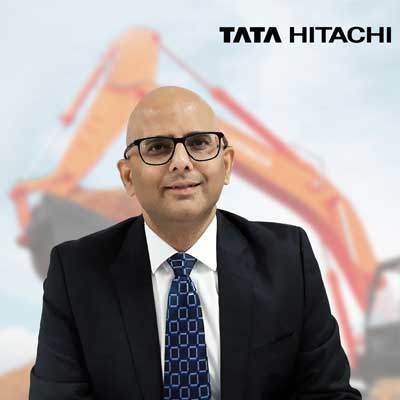Rahul Shorey, National Head – Construction, Tata Hitachi Construction Machinery, speaks on challenges faced by the backhoe loaders market.
How do you look at the current scenario of backhoe loaders in India? What is the current market size of backhoe loaders in India?
The Indian backhoe loader market had been growing year-on-year for four straight years till 2018-19. It grew with a CAGR of more than 20 per cent per year, peaking in 2018-19. In 2019-20 the market shrunk by 20 per cent due to factors such as elections and constrained liquidity post the ILFS crisis.
The market started to recover in the last quarter of 2019-20, before Covid-19 lockdowns hit demand. However, in the last financial year, the market recovered sharply and grew by 19 per cent to over 43,000 units sold. This was primarily due to the increased thrust of the government last year on rural infrastructure, supported by a strong monsoon leading to increased investment in agriculture and record procurement of farm produce. This was also aided by the deferment of implementation of CEV4 norms to April 1 this year.
How optimistic are you in the sector in terms of project execution and growth?
With CEV4 implementation, the increased prices are expected to impact first time buyers and we do expect to see a slightly muted demand in the near term. However, we do expect robust growth in the construction equipment industry, driven by the government’s thrust on both urban and rural infrastructure. The central government alone has enhanced capex outlay by 26 per cent on a year-on-year basis. Substantial allocations have been made to the government’s infrastructure initiatives like Jal Jeevan Mission, PM Gram Sadak Yojana, PM Awas Yojana, AMRUT and smart cities, among others. These factors, combined with a robust monsoon for the third consecutive year, are likely to further drive growth later this year.
What are the upcoming digital technologies in backhoe loaders? How interested are contractors towards these technologies?
Our backhoe loaders come equipped with InSite, our in-house a suite of telematics solutions. InSite provides information on aspects like location data, asset utilisation, geo fencing, operations monitoring, health alerts and fuel level monitoring. This enables equipment owners to have better control over their operations and thereby realise a better return on investment.
We are gradually seeing an increasing level of interest among customers as they are realising the benefits that accrue due to these technologies. Customers are increasingly accepting them, as they ensure a better handle over customers’ operations, driven by the data in terms of condition of operations, fuel levels, maintenance notifications and daily SMS reports, among others.
What are the latest offerings in your product range?
We offer a wide range of hydraulic excavators, backhoe loaders, wheel loaders and mining equipment. In the backhoe loader segment, we recently introduced our CEV4 compliant SHINRAI PRIME with superior features and technology, offering better fuel efficiency and enhanced performance.
What are the challenges faced by the backhoe loaders market?
The implementation of BSIV emission norms is presenting some key challenges for both sellers and buyers. The first major challenge from the buyer’s perspective is the operation and maintenance of the new range of BSIV equipment. Many of our customers already own tippers as part of their fleet. Most of these customers are familiar with the usage of BS4 and BS6 compliant tippers whose engines and after treatment systems are similar to the ones being used on CEV4 on-road construction equipment.
For first-time buyers we have institutionalised training and familiarisation procedures at the time of commissioning our equipment. safety precautions as well as the proper operation and maintenance of these systems – particularly with respect to the use of urea in the upkeep of the aftertreatment system. This process will help customers get used to the new technology faster. We believe that this technology adoption will be easier than during the implementation of the first emission norms for engines with the incorporation of turbochargers in the 1990s.
In terms of demand, we do see some impact given the significant increase in prices of these machines. We are also watching closely, the impact on rental rates because of this change. We expect that a part of the market may downshift to the 49hp backhoe loader as it is outside the ambit of current emission norms. We also anticipate some shift to excavators too, given inherent operational efficiencies.
In this context, we are trying to help customers realise the benefits on long-term costs of equipment operations. In addition, from a manufacturer’s perspective, we have increased the oil and filter change intervals to reduce the maintenance costs for our equipment. We have, for instance, reached industry-leading standards in terms of hydraulic oil change intervals. Such measures, while reducing maintenance cost for the customer, will also further reduce the environmental impact caused by frequent oil disposal.
With the government focusing on the vision of ‘Atmanirbhar Bharat’, how would it catapult growth for the construction and engineering equipment market?
The $6.5 billion Indian construction equipment Industry is an enabler of Infrastructure development in the country and a driver of the Rs 111 lakh crore National Infrastructure Pipeline (NIP). The industry has the potential to become a global manufacturing and export hub provided a conducive policy environment and support is made available. With the Government’s enhanced focus on infrastructure aimed at reviving India’s economy from the impact of Covid-19, the Indian construction equipment Industry will play a vital role in supporting efficient and timely execution of the nation’s critical infrastructure projects.
The Government’s Aatmanirbhar Bharat initiative is a step in the right direction, aimed at reducing imports, encouraging domestic manufacturing, and making India self-reliant. The Indian CE Industry is aligned to this vision and envisages becoming the second largest construction equipment market in the world and growing three times its size in by 2030. However, for the Industry to realise its Vision Plan 2030, a robust operating ecosystem is essential to drive indigenisation in the sector.
It should be noted that on an average, 25 to 40 per cent of construction equipment components by value are imported as high precision components from manufacturers largely based in Japan and Korea. These manufacturers are not keen to invest in mother technologies in India due to the low scale of domestic volumes. The construction equipment Industry is therefore, seeking from the Government, incentive schemes such as the production linked incentive (PLI) to enable it to develop indigenous technologies and capabilities. This will go a long way in reducing India’s import dependence, driving self-reliance, and strengthening domestic supply chains, which include MSMEs.
How has your company fared with the challenge of Covid-19? What is the secret to success?
There is no one-size-fits-all approach in this context. Our responses evolved in response to the changing dynamics of the pandemic. We focussed on several aspects from employee safety to business imperatives. For employee health, wellbeing, and safety we have put in place SOPs for prevention, early detection, and control of Covid-19 across all our manufacturing facilities as well as warehouses, sales and service offices, FMC sites and training centres. These have been implemented with mandatory rigour across the organisation.
The pandemic has also led to a shift towards adoption of digital communication channels, which have been successfully utilised to facilitate communication within the organisation and to maintain connect with customers and external stakeholders. Our HR team has been regularly organising virtual training for employees while the senior management has maintained a regular connect with all employees updating them of the prevailing market situation and ensuring full care and support to those infected by the virus.
From a business point of view, while physical connect remains an integral part of our sales activities, we continue to invest in digital technologies and in enhancing the skillsets of our employees to ensure smooth continuity of business operations. This has remained an important part of our focus from the start, and we have been continuously upgrading our infrastructure and investment in customer support. We ensure greater proximity to customers through over 200+ touchpoints covered by our 49 domestic and three international dealers.
While we have ensured longer service intervals due to the inherent durability and reliability of our equipment, including on-board diagnosis, we are fully geared up to support our customers to reduce downtime, even during lockdowns. We have set up a central call centre for any support related issues. We have also instituted multiple digital communications channels to pre-empt and minimise breakdown and unnecessary downtime.
In addition, our warehouses have developed procedures to work safely under pandemic conditions. Dealer warehouses and dealer teams are able to deliver parts through local transport and courier wherever possible. Our online portal also makes it more convenient for customers to place orders. All these institutionalised measures have ensures robust sales and delivery, after-sales support and services, including faster spare parts supply to customers.
How do you look at the future of backhoe loaders in India?
The increased prices due to transition to CEV4 norms are expected to impact first time buyers and we expect to see an impact on relative volumes. The governments thrust on both urban and rural infrastructure, and the substantial budgetary allocations this year are likely to drive growth in backhoe loaders later this year. This will boost demand for construction equipment. Additionally, highway and road construction will support demand for wheel loaders.
There is a narrowing of price levels between excavators and backhoes is expected to have an impact on relative volumes. We are continuing to watch this play out. However, backhoe loaders will continue to have an edge given their mobility advantage, as well as a resale market that is more robust than that of excavators.




















